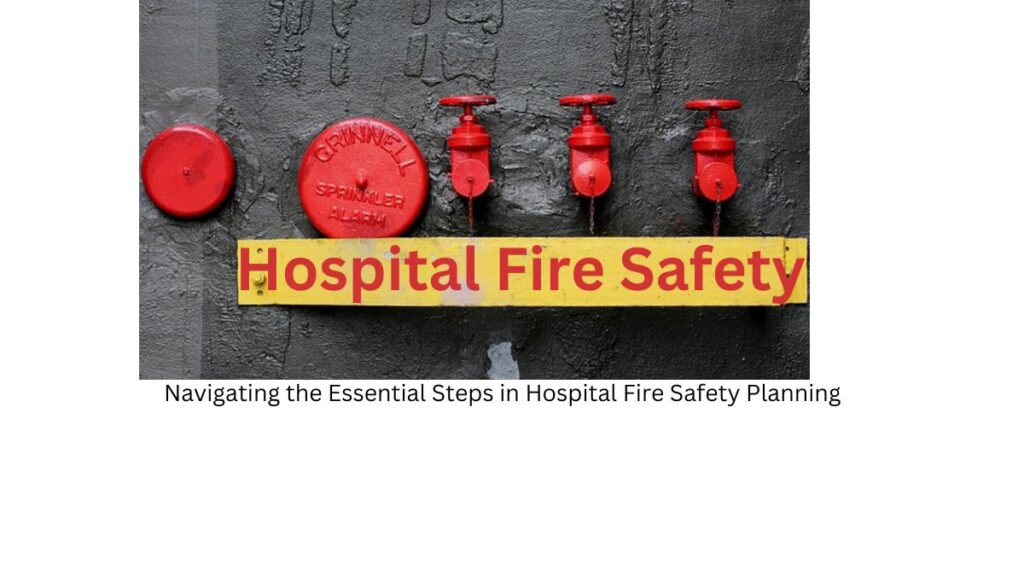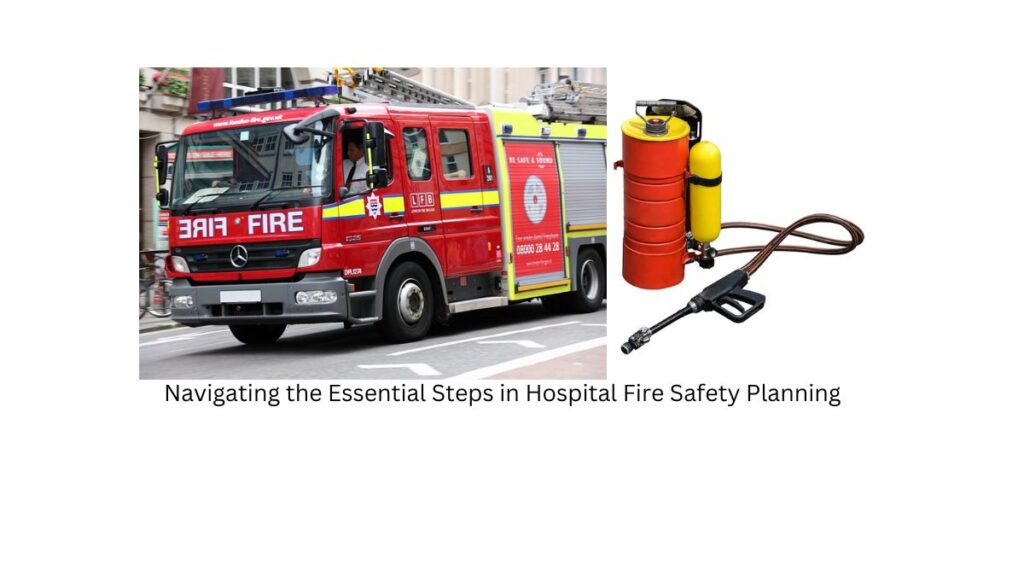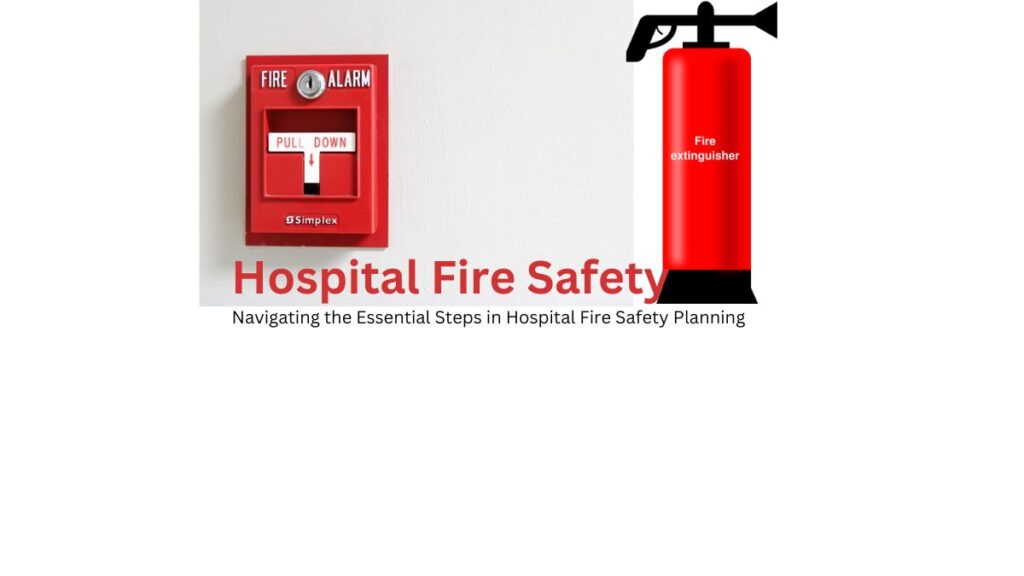Introduction:
Patient-Centric Safety: Navigating the Essential Steps in Hospital Fire Safety Planning

In the realm of healthcare, patient safety takes center stage, and ensuring a secure environment is paramount. One critical aspect of this endeavor is formulating a meticulous fire safety plan tailored to the unique needs of hospitals. This article delves into the key steps involved in creating a patient-centric hospital fire safety plan, emphasizing the importance of proactive measures for the well-being of both patients and healthcare professionals.
What are the essential provisions to be made within a hospital fire safety?
Ensuring fire safety within a hospital is critical to protect patients, staff, and valuable medical resources. Here are essential provisions to be made within a hospital for fire safety:

- Fire Detection Systems: Install state-of-the-art fire detection systems throughout the hospital, including smoke detectors, heat detectors, and fire alarms. These systems should be interconnected to provide early warning and swift response in case of a fire.
- Fire Suppression Systems: Implement automatic fire suppression systems such as sprinklers, especially in high-risk areas like electrical rooms and storage spaces. These systems can help contain or extinguish a fire before it spreads.
- Emergency Lighting: Ensure adequate emergency lighting throughout the hospital, including exit signs and pathway illumination. This is crucial in case of power outages during a fire, helping people navigate safely through the facility.
- Evacuation Plans and Signage: Develop clear and well-marked evacuation plans with designated escape routes. Install visible and easily understandable signage throughout the hospital to guide occupants to exits. Regularly conduct drills to familiarize staff with evacuation procedures.
- Fire-Resistant Construction Materials: Use fire-resistant construction materials in the hospital’s infrastructure, including walls, doors, and ceilings. This helps contain the spread of fire and provides additional time for evacuation.
- Electrical Safety Measures: Implement electrical safety measures, including regular inspections of electrical systems, proper wiring practices, and the use of surge protectors. Electrical malfunctions are common causes of fires, and preventive measures are crucial.
- Safe Storage and Handling of Flammable Materials: Establish strict protocols for the storage and handling of flammable materials within the hospital. Ensure that storage areas are well-ventilated and equipped with safety features to minimize fire hazards.
- Staff Training and Drills: Conduct regular fire safety training sessions for all hospital staff. Ensure that employees are familiar with fire safety protocols, evacuation procedures, and the operation of firefighting equipment. Regular drills help reinforce preparedness.
- Accessibility for Persons with Disabilities: Consider the needs of individuals with disabilities in fire safety planning. Ensure that evacuation routes are accessible and that staff is trained to assist patients with mobility challenges during emergencies.
- Emergency Response Teams: Establish and train dedicated emergency response teams within the hospital. Designate roles and responsibilities for staff members during a fire emergency, including fire wardens and individuals trained in first aid.
- Fire-Resistant Medical Equipment: Select medical equipment that is resistant to fire or that has built-in safety features. This helps prevent equipment-related fires and ensures the safety of patients and healthcare providers.
- Monitoring and Maintenance: Implement a robust system for monitoring and maintaining fire safety equipment. Regular inspections, testing, and maintenance of fire detection systems, suppression systems, and firefighting equipment are essential to ensure their effectiveness.
- Collaboration with Local Authorities: Collaborate with local fire departments and emergency services. Ensure that hospital staff is familiar with local emergency response procedures, and coordinate drills and training exercises with external emergency personnel.
- Communication Systems: Establish effective communication systems, including intercoms and two-way radios, to facilitate communication during emergencies. Clear communication is crucial for coordinating response efforts and disseminating information to occupants.
By implementing these provisions, hospitals can create a comprehensive and effective fire safety plan that prioritizes the well-being of patients, staff, and visitors. Regular updates and continuous training are essential to adapt to evolving risks and best practices in fire safety.
How to use a fire extinguisher in a hospital emergency?
Using a fire extinguisher in a hospital emergency requires a careful and coordinated approach to ensure the safety of patients, staff, and visitors. Here’s a step-by-step guide on how to use a fire extinguisher in a hospital setting:

1. Evaluate the Situation:
- Before attempting to use a fire extinguisher, assess the size and nature of the fire. Only consider using a fire extinguisher for small, containable fires. If the fire is spreading rapidly or poses a significant risk, evacuate the area immediately and alert the emergency services.
2. Sound the Alarm:
- If not already done, activate the fire alarm system to alert everyone in the hospital. This helps initiate the evacuation process and ensures that emergency services are notified.
3. Evacuate if Necessary:
- Prioritize the safety of patients, staff, and visitors. If the fire is not quickly manageable with a fire extinguisher or if it continues to grow, initiate evacuation procedures following the hospital’s established protocols. Direct individuals to the nearest safe exit routes.
4. Call Emergency Services:
- Dial the emergency services number (e.g., 911) to report the fire and provide them with essential information, including the location, size of the fire, and any potential hazards.
5. Use the Right Type of Fire Extinguisher:
- Ensure that you are using the correct type of fire extinguisher for the specific class of fire. Hospitals typically have multi-purpose fire extinguishers suitable for Class A, B, and C fires. These extinguishers use a dry chemical agent.
6. Remember the PASS Technique:
- P – Pull: Pull the pin from the extinguisher to prepare it for use.
- A – Aim: Aim the nozzle or hose at the base of the fire, not the flames.
- S – Squeeze: Squeeze the handle to release the extinguishing agent.
- S – Sweep: Sweep the nozzle from side to side across the base of the fire until it is fully extinguished.
7. Maintain a Safe Distance:
- Stand at a safe distance from the fire, keeping yourself out of the path of smoke and flames. Maintain a distance of 6 to 8 feet.
8. Continuous Evaluation:
- Continuously reassess the situation. If the fire is not responding to the extinguisher or if it reignites, evacuate immediately and wait for professional firefighters to handle the situation.
9. Provide Assistance to Others:
- Assist patients, especially those with mobility challenges, in evacuating the area. Designate responsible staff members to help with the evacuation of patients and visitors.
10. Report and Debrief: – After the emergency is resolved, report the use of the fire extinguisher to the appropriate authorities within the hospital. Conduct a debriefing to review the response and identify areas for improvement in the fire safety plan.
It’s crucial for hospital staff to receive regular training on fire safety procedures, including the proper use of fire extinguishers. Additionally, hospitals should have designated individuals trained as fire wardens or emergency response personnel to lead evacuation efforts and coordinate with emergency services.
Conclusion:
Prioritizing patient-centric safety in hospital fire safety planning is an ongoing commitment to the well-being of all stakeholders. By following these key steps, hospitals can establish a robust and effective fire safety plan that safeguards lives and upholds the highest standards of patient care.





